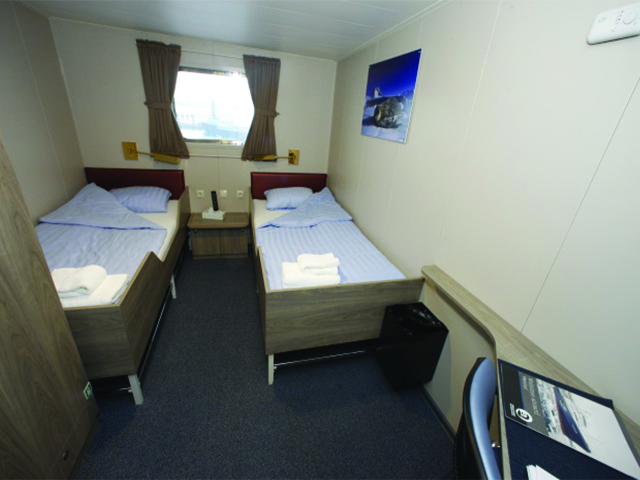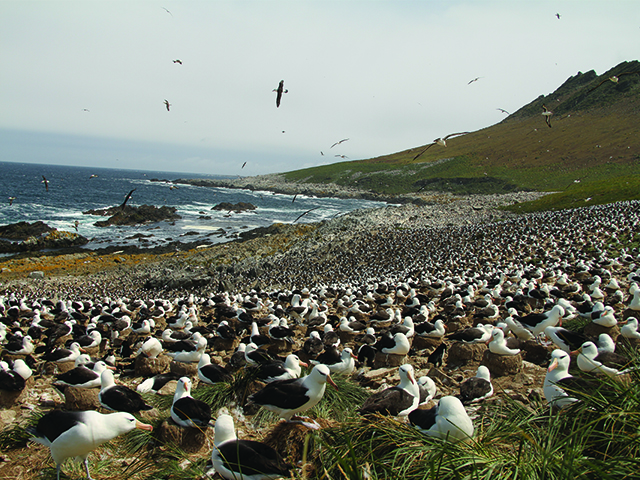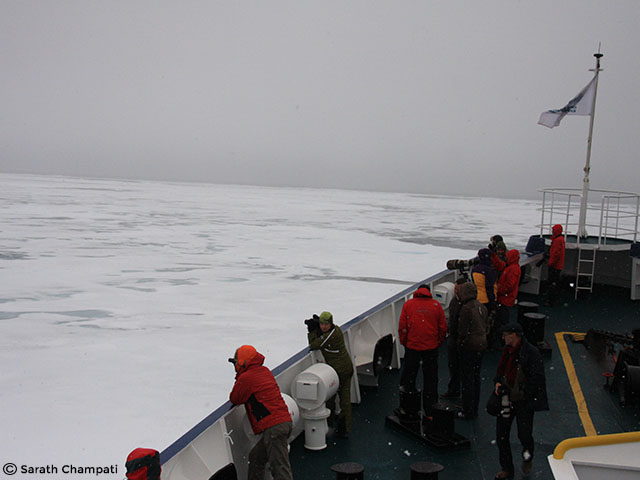- 1Ushuaia , Argentina to Beagle Channel
We start the tour to antarctic at Ushuaia, in the afternoon. Ushuaia is the southernmost city in the world located in the shadow of the Andes. This beautiful city is located to the south of the Beagle Channel and is the biggest settlement on the Channel.
We will sail through the scenic waterway of the Beagle Channel during the afternoon. Beagle Channel is a strait separating islands of the Tierra del Fuego Archipelago, Argentina. It separates Isla Grande de Tierra del Fuego from the islands Nueva, Picton, Navarino, Hoste,Londonderry, Stewart Islands and other smaller ones to the south. The Channel gets its name from the ship ‘Beagle’, in which the famous scientist Charles Darwin had done a hydrographic survey of the region. We’ll sail through this scenic waterway
Our vessel and home for the next few days will be M/v “Plancius,” where we will be accommodated in Private Window rooms.
Meals : DinnerAccommodation : M/v "Plancius" - 2Atlantic Ocean
We will be sailing across the Atlantic Ocean today. En route, we may see several species of Albatrosses, Storm Petrels, Shearwaters and Diving Petrels.
Enjoy the day on the deck of the vessel, spotting the birds, reading a book and pampering yourself with the company of the blue sea.
Apart from the world class accommodation facilities, M/v “Plancius”, also has a restaurant, lecture room, observation lounge (with bar) and ample deck space for travelers to enjoy the scenery and wildlife around them.
Meals : Breakfast, Lunch & DinnerAccommodation : M/v "Plancius" - 3Atlantic Ocean to Falkland Islands , South Atlantic Ocean
On Day 3 we arrive at Falkland Island, an archipelago on South Atlantic Ocean situated about 460 km away from the coast of South America. Stanley, on East Falkland, is the capital of this archipelago.
The day will be spent on the western side of the Falkland Islands. We will hike along the shore of the Carcass Island, from where we can see Magellanic and Gentoo-Penguins. We might also encounter Waterfowl and Night Herons. Carcass Island, in the north-west of the archipelago, is owned by Rob and Lorraine McGill. The traditional Island high-tea with home-baked cakes and cookies is a must try.
In addition, as we visit Saunders Island, we will be able to observe Rockhopper Penguins, Black-browed Albatrosses and King Cormorants. Saunders Island is located to the north of the archipelago and has a large variety of wildlife. Four species of penguins can be found here as well as a colony of 11,000 breeding pairs of Black-browed Albatrosses.
Meals : Breakfast, Lunch, DinnerAccommodation : M/v "Plancius" - 4Falkland Islands , South Atlantic Ocean
We will spend the day at Stanley, capital of the Falklands. Experience the Falkland culture here, which is an enigmatic mix of South American characteristics as well as a distinct Victorian charm. We will be able to see quite a few stranded clipper ships around Stanley, many of which have been there for almost a century.
Stanley, the capital of the Falkland Islands, still has the atmosphere of a Scottish coastal village. Shipwrecks, Landrovers, small houses with colored roofs and traditional British pubs enhance the village setting. The town has several shops, a bank, hotels and pubs as well. Special Island stamps are for sale and there is an excellent museum here, on the history of the islands. Take the opportunity to explore the town on your own. In the vicinity there are nice walking areas with a colony of Magellanic Penguins and other interesting bird species.
Meals : Breakfast, Lunch, DinnerAccommodation : M/v “Plancius” - 5,6Atlantic Ocean
We will be sailing across the Southern Atlantic Ocean for the next few days. En route, we may see several species of Albatrosses, Storm Petrels, Shearwaters and Diving Petrels.
On our way to South Georgia we will cross the Antarctic Convergence. The Antarctic Convergence is a curve continuously encircling Antarctica where cold, northward-flowing Antarctic waters meet the relatively warmer waters of the subantarctic. Antarctic waters predominantly sink beneath subantarctic waters, while associated zones of mixing and upwelling create a zone very high in marine productivity, especially for Antarctic krill. This line, like the Arctic tree line, is a natural boundary rather than an artificial one, like a line of latitude. It not only separates two hydrological regions, but also separates areas of distinctive marine life associations and of different climates.
As we enter the waters of the Antarctic, the temperature will drop nearly 10 degree Celsius in just a few hours! Near the Convergence area, a multitude of southern seabirds like Petrels, Prions and Skuas may be seen hovering near the ship.
The island of South Georgia is a United Kingdom Overseas Territory and is one of the remotest and wildest places in the world! It is located 1,400 km east of the Falkland Islands. The island has more than 160 glaciers dropping down into the sea.
Huge numbers of seabirds and marine mammals breed along South Georgia's Tussock Grass fringed shores. Save for the rusting remnants of the old whaling stations, the island is virtually untouched by man and so offers unique opportunities to observe the unparalleled wildlife and spectacular scenery of this most beautiful part of the Southern Ocean, a true Antarctic oasis.
The first recorded landing on South Georgia was made by the famous British explorer James Cook. In the early 20th century, South Georgia became the centre of the Southern Ocean whaling industry. Many Norwegian and British companies built settlements and whaling stations in the sheltered fjords. Whaling was carried out in the region until 1964. Nowadays the whales and seals are fully protected. The Fur and Elephant Seal populations have recovered and are again numerous on the beaches. The big whale species are also recovering slowly and are now frequently spotted on our trips.
Meals : Breakfast, Lunch, DinnerAccommodation : M/v "Plancius" - 7,8,9,10South Georgia, Southern Atlantic Ocean
We shall spend the next few days in South Georgia. We shall visit the bay of Elsehul, which has a very active Fur Seal breeding beach. We then take course to Right Whale Bay, Salisbury Plain, Gold Harbour and Cooper Bay which will give us a good opportunity to see a wide spectrum of landscapes and wildlife, like the introduced Reindeer, Elephant seals, King and Macaroni Penguins.
Gold Harbor is the abridged version of South Georgia’s wildlife and scenery in one place. It is regarded by many as the most beautiful spot on the island. King Penguins, Gentoo Penguins and Elephant Seals are the players in this natural amphitheater.
At Fortuna Bay we might try to follow in the footsteps of the great British Explorer Ernest Shackleton and hike over to Stømness Bay. Fortuna Bay is a scenic fjord into which Shackleton descended during his epic crossing of the island in 1916. The last leg of this walk is sometimes retraced on our trips. We can spot a King Penguin colony at the head of the bay.
At Grytviken we will see an abandoned Norwegian whaling station. King Penguins now walk the streets and Seals have taken over the buildings. While at Grytviken, a chance to visit the Whaling History Museum and Shackleton’s grave, which is located nearby, is also on offer. Sir Ernest Shackleton was buried at Grytviken in 1922. A toast at his grave is a tradition with travelers.
One of the final highlights of our cruise might be a visit to Prion Island, where we will witness the breeding phenomena of the huge Wandering Albatross and admire their amazing displays.
We will depart from South Georgia in the afternoon of day 10
Meals : Breakfast, Lunch, DinnerAccommodation : M/v “Plancius” - 11South Georgia, Southern Atlantic Ocean
At sea, our ship is again followed by a multitude of seabirds. At some point we might encounter sea-ice, and it is at the ice-edge where we might have a chance to see some high-Antarctic species like the Maccormick Skua, Snow Petrel and the elusive Emperor Penguin.
Meals : Breakfast, Lunch, DinnerAccommodation : M/v “Plancius” - 12South Orkney Islands,Southern Ocean
We will visit the Orcadas station, an Argentinean base located in the South Orkney Islands. We will have a chance to interact with the friendly base personnel and also see the facilities used there. We can also enjoy the wonderful views of the surrounding glaciers.
The South Orkney Islands are located east of the South Shetland Islands and consist of four major islands. They were named, together with the South Shetland Islands, after the islands in northern Scotland by the Scottish sealers that frequented the area. The islands were discovered only in 1821 when they were sighted by the respectively sealers George Powell and Nathaniel Palmer. The islands consist mainly of rock and ice (85 % is glaciated), with little vegetation. Argentina (Orcadas station) and the United Kingdom (Signy Station) have scientific stations on the islands.
Meals : Breakfast, Lunch, DinnerAccommodation : M/v “Plancius” - 13Southern Ocean
We will spend the whole day at sea as we sail towards the Antarctic Peninsula.
The Antarctic Peninsula is part of the Antarctic Continent and is the southern continuation of the mountain chain that runs from North America through South America into the Scotia Sea. Here it continues mainly as a sub-marine ridge, the Scotia Ridge, until it comes above sea-level at the northern tip of the Antarctic Peninsula. The peninsula consists of an 800 km long mountain chain, the highest peaks rising to approximately 2,800 m and numerous off-lying islands. The Peninsula offers the most dramatic scenery and biggest variety of wildlife in Antarctica. Visitors are easily mesmerized by the huge amount of ice-bergs, glaciers, high mountains and the abundant and tame wildlife.
Earlier exploitation was again the major force behind the early explorations. Nowadays the Antarctic Peninsula is protected by the Antarctic Treaty, which has been signed by 46 countries. The signatory parties have agreed to abstain for 50 years from recognizing, disputing, or establishing territorial sovereignty claims. The parties also agreed to set aside Antarctica as a scientific preserve, established freedom of scientific investigation and banned military activity on the continent.
Meals : Breakfast, Lunch, Dinner Accommodation : M/v “Plancius”Accommodation : M/v “Plancius” - 14,15,16,17Southern Ocean to Antarctic Peninsula
Now, we will sail into the Weddell Sea, discovered in 1823 by the British sealer James Weddell.. The huge Weddell Sea, at its widest is more than 2000 km across, is located on the south-east side of the Antarctic Peninsula. The Sea is considered high-Antarctic in contrast to the north-west coast of the Peninsula, which is low-Antarctic. The Sea extends so far south that it is under the direct influence of the very cold Antarctic Continental Climate. The south-western and southern borders of the sea are formed by the Larsen and the Filchner-Ronne Ice Shelves. These shelves produce the huge tabular ice-bergs that are found in abundance in the Weddell Sea. We will sail into the Weddell Sea through the ice-clogged Antarctic Sound, named after the expedition ship of Otto Nordenskiöld. The sound that separates the tip of the Antarctic Peninsula from Dundee Island is also named “Ice-berg Alley”, because of the huge ice-bergs that are often seen here.
We will also try to visit Paulet Island, a volcanic island, located just 5 kilometers, south-east of Dundee Island. If the weather conditions permit; we will land on this remote island to see the remains of the Nordenskiöld expedition as well as thousands of Adelie Penguins. The island has a diameter of about 3 km and the summit crater is 353 m high. Geothermal heat keeps the island ice-free. The island is home to a colony of over 100,000 pairs of Adélie Penguins. We might also have time to visit Brown Bluff and land at the northern tip of the Antarctic Peninsula. Brown Bluff is located on the Antarctic Peninsula, at the west side of the Antarctic Sound. Below the steep cliffs, Adélie and Gentoo Penguins breed. Leopard Seals, in search of penguins, often patrol the shore.
Later on, we will sail to Deception Island. The ring-shaped island is in fact the top of a volcano, a caldera. On one side there is a narrow entrance through which ships can enter the crater. Below some of the beaches, the seawater is heated by the still active volcano in a geothermal manner. In Whalers Bay the remains of an early 20th century whaling station can be seen. It is one of the safest harbors in Antarctica. Here we find thousands of Cape Pigeons and many Dominican Gulls, Brown and South Polar Skuas and Antarctic Terns.
We can spot the Storm Petrels nest in the ruins of the whaling station in Whalers Bay. If you want to indulge in some adventurous hiking, you can opt to hike from Baily Head over the ridge of the crater into Whalers Bay, while our ship braves its entrance into the crater through the spectacular Neptune’s Bellow into the ring of Deception Island.
On our way further South we will sail across the Gerlache Strait to Cuverville Island, a small precipitous island, nestled between the mountains of the Antarctic Peninsula and Danco Island. It contains a large colony of Gentoo Penguins and breeding pairs of Brown Skuas. If time and conditions permit, we will sail to Neko Harbour and Paradise Bay, punctuated with myriad icebergs and deep cut fjords. Here, we shall get a chance to opt for some adventurous zodiac cruising (zodiacs are small inflatable boats that have a capacity of around ten to eleven passengers) between the icebergs in the inner parts of the fjords. To add to the excitement, we may chance upon Humpback Whales and Minke Whales.
Meals : Breakfast, Lunch, DinnerAccommodation : M/v “Plancius” - 18Drake Passage
On our way north we are again followed by a great selection of seabirds while crossing the Drake Passage. The Drake Passage or Mar de Hoces is the body of water between the southern tip of South America at Cape Horn, Chile and the South Shetland Islands of Antarctica. This passage connects the southwestern part of the Atlantic Ocean (Scotia Sea) with the southeastern part of the Pacific Ocean and extends into the Southern Ocean. Before the passage opened, the Atlantic and Pacific Oceans were separated entirely with Antarctica being much warmer and having no ice cap. The joining of the two great oceans started the Antarctic Circumpolar Current and cooled the continent significantly.
Meals : Breakfast, Lunch, DinnerAccommodation : M/v “Plancius” - 19Drake Passage to Ushuaia , Argentina
This is the last day of our cruise. We will reach Ushuaia in the morning and disembark the vessel.
Meals : Breakfast
- Accommodation and meals as indicated in the itinerary
- All shore excursions
- Boat trips
- Information Kit
- Lectures by naturalists
- Point to point arrival and departure transfers
- Pre-scheduled group transfer from the vessel to the airport in Ushuaia
- Rubber boots/Snow shoes
- Taxes
- Airport transfers
- All items of personal nature
- Any increase in taxes, fuel cost and emergency rescue costs
- Domestic airfare or Train fare
- International airfare
- Meals and drinks not specified in the itinerary
- Optional activities (if any) and personal expenses
- Pre and post cruise/land arrangements
- Souvenirs
- Visas, Vaccination and Insurance
For Advanced level tours, we recommend previous experience of the activity involved. These are our most challenging and advanced expeditions. They include long walks, cycling, trekking, hiking or rafting in variable weather conditions for more than ten hours a day. These trips may often be over three weeks in duration. Ascents and descents are over 1000m at altitudes up to 6000m and the climate can be rigorous and challenging. Excellent physical condition and previous mountain trekking experience or appropriate preparation is essential.






